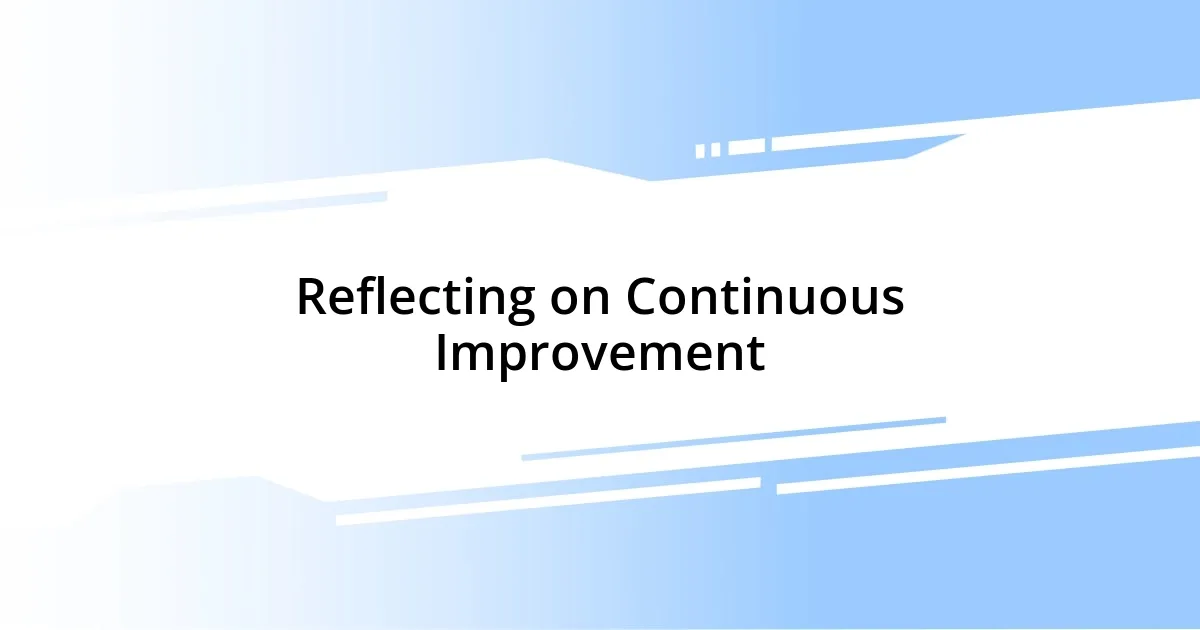Key takeaways:
- Prioritizing quality over quantity leads to deeper relationships and more meaningful work experiences.
- Setting specific, measurable goals enhances focus, reducing overwhelm and improving overall satisfaction.
- Continuous self-reflection and seeking feedback foster growth and accountability in work quality.
- Embracing discomfort and learning from setbacks cultivates resilience and drives personal development.

Understanding Quality Over Quantity
Understanding the difference between quality and quantity can profoundly impact various aspects of our lives. I remember when I first started my career—focused on landing as many projects as possible. It wasn’t until I put extra effort into just a couple of them that I began to see true success. Isn’t it interesting how sometimes less really is more?
When I reflect on my experiences, I think about the times I chose deep connections over a broad social circle. Each friendship I nurtured became richer and more meaningful. This realization served as a reminder that investing time and effort in a few significant relationships can be far more rewarding than spreading oneself too thin.
In the world of productivity, I’ve often asked myself: am I checking off boxes, or am I making real progress? Focusing on a smaller number of high-impact tasks rather than just accumulating a long to-do list has been a game changer for me. It’s taught me that the depth of my work often outweighs the breadth, leading me to more profound feelings of accomplishment and fulfillment.

Defining Your Priorities
Defining what truly matters in our lives is essential for making meaningful decisions. I’ve struggled with prioritizing tasks that seemed urgent but weren’t genuinely important. For instance, I used to spend hours replying to every email, only to realize later that the time would have been better spent on a pivotal project that could drive my career forward. This shift in focus from being reactive to being proactive felt liberating.
As I prioritize my relationships, I’ve learned the power of quality interactions. There was a time I considered boosting my social media following; however, I found deeper satisfaction in engaging sincerely with just a handful of close friends. Sharing a coffee with someone who truly understands you can be more enriching than trying to keep up with hundreds of superficial connections. It’s a revelation that has changed how I perceive value in my everyday life.
In essence, defining my priorities has always been about intentionally choosing paths that resonate with my goals and values. I think about how I plan my week; now, I block out time to work on projects that matter instead of rushing through tasks. This has led to greater satisfaction and a sense of accomplishment that I never experienced before.
| Quality | Quantity |
|---|---|
| Depth in relationships | Breadth in network |
| Meaningful work | Numerous tasks |

Setting Measurable Goals
Setting measurable goals has been a turning point in my approach to both projects and personal growth. Initially, my goals were broad and vague, leaving me feeling overwhelmed and directionless. However, I quickly learned that setting specific, measurable objectives transformed my focus. For example, during a project at work, I focused on delivering three high-quality presentations instead of striving to complete ten generic ones. This shift not only improved the quality of my work, but it also received positive feedback from my peers.
To ensure you’re on the right track, consider these steps when setting measurable goals:
- Define specific outcomes you want to achieve.
- Recruit metrics to track your progress, such as time spent or results obtained.
- Establish deadlines that encourage urgency without sacrificing quality.
- Break larger goals into smaller, actionable steps, which makes them less daunting.
- Regularly review and adjust your goals to ensure they remain relevant and motivating.
Implementing these strategies has allowed me to discover the joy in achieving milestones that truly resonate with my aspirations. With each small victory, I’ve felt a renewed sense of motivation that fuels my passion for quality work.

Techniques for Quality Assessment
Quality assessment can often feel overwhelming, but I’ve found that focusing on specific techniques can drastically streamline the process. One method I’ve used is creating a checklist that outlines essential quality indicators for each task. When I started using this tool, I realized how much more effectively I could evaluate my work. Instead of just skimming through, I was actually diving into the criteria that mattered most.
Another effective technique is seeking feedback from trusted individuals. Early in my career, I hesitated to share my drafts with colleagues, fearing judgment. However, I soon discovered that constructive feedback was invaluable. By inviting others to weigh in on my work, I gained fresh perspectives that not only highlighted areas for improvement but also reinforced what I was doing well. Have you ever had a moment where someone else’s insight completely changed how you viewed your work?
Finally, I embraced a method called “5 Whys,” which involves asking “why” five times to pinpoint the root cause of an issue. I applied this technique when my project didn’t meet expectations, and digging deeper revealed some overlooked assumptions. It was a game-changer in my quality assessment approach. Understanding the “why” behind my actions has not only elevated my work but also deepened my personal reflection. These strategies may seem simple, yet they profoundly shape how I navigate quality in every aspect of my life.

Strategies for Maintaining Quality
To maintain high quality, I’ve learned that consistency is key. For instance, I established a daily routine that includes dedicated time for deep focus. This habit not only helps me produce my best work but also ensures I become increasingly skilled at what I do. Have you ever found yourself less productive when there’s too much chaos? I know I have, and by creating a structured day, I curbed that chaos.
Another effective strategy is investing in continuous learning. I remember signing up for a workshop on advanced data analysis, which seemed unrelated to my immediate projects. Surprisingly, the skills I gained during that workshop significantly enhanced my problem-solving abilities. The knowledge didn’t just boost my confidence; it also allowed me to tackle complex tasks with a new perspective. How often do we shy away from learning opportunities because they don’t align perfectly with our current trajectory?
Lastly, I always keep a feedback loop alive. After completing a project, I jot down what worked well and what didn’t, and then I share my thoughts with my team. This reflection has been enlightening; it encourages accountability and fosters a team culture focused on improvement. When was the last time you evaluated your work after it was done? I find that embracing this habit has kept my quality work evolving, ensuring I stay true to prioritizing quality in every endeavor I undertake.

Evaluating Impact of Quality Choices
Evaluating the impact of quality choices is a journey of discovery. I remember a project where I opted for an in-depth research phase instead of rushing through. The outcome wasn’t just a successful deliverable; it was a profound satisfaction that stemmed from knowing I had genuinely contributed something valuable. When was the last time you took a step back to appreciate the depth of your work?
Sometimes, it’s easy to underestimate how our decisions today shape our future outcomes. I once took on a project that initially seemed tedious but required meticulous attention. While it felt burdensome at the time, that single choice laid the foundation for future endeavors. Reflecting on this has taught me that quality choices often ripple outward, creating lasting effects. Can you recall a moment when a tough choice ended up being a pivotal point in your journey?
Finally, assessing quality choices requires a willingness to confront discomfort. I often felt anxious when facing the reality of my decisions, especially when results didn’t align with my expectations. Yet, every misstep offered a lesson that enriched my understanding. Embracing discomfort has proved crucial; it’s become a driving force behind my growth and commitment to quality. How do you tackle the challenges that come with evaluating your choices? I’ve found that facing them head-on has led to my most significant breakthroughs.

Reflecting on Continuous Improvement
Certainly! Here’s a thoughtful take on “Reflecting on Continuous Improvement,” tailored to fit seamlessly with your existing content while incorporating personal anecdotes, emotional insights, and rhetorical questions.
Reflecting on continuous improvement isn’t always easy, but it’s vital to my growth. I recall a time when I decided to dedicate a full day just to self-reflection after a challenging project. I switched off my phone and pulled out my journal, writing down my thoughts. That day became a pivotal moment for me; by honestly assessing my strengths and areas for growth, I uncovered insights that transformed how I approached my work. Have you ever taken a moment to just breathe and let your mind wander? Sometimes, it’s in those quiet moments that the best ideas flourish.
As I look back, I’ve come to see that continuous improvement is more about the journey than the destination. There was a project that didn’t go as planned, and it was tempting to focus solely on what went wrong. Instead, I chose to analyze the process and extract lessons from it. I still remember the thrill of discovering new techniques that improved my skills over time. That experience taught me the importance of resilience and adaptability. How do you react when faced with setbacks? I’ve learned that each stumble often leads to a more profound understanding of my craft.
Moreover, I find that surrounding myself with growth-oriented individuals fosters a culture of improvement. A few months ago, I attended a networking event where I connected with fellow professionals who shared their own struggles and triumphs. Hearing their stories ignited a fire in me to push my boundaries. That exchange of experiences reminded me that we’re all on this journey together. Isn’t it inspiring how the stories of others can light the path to our own improvements? Embracing this collective experience has profoundly enriched my commitment to continuously enhance the quality of my work.














